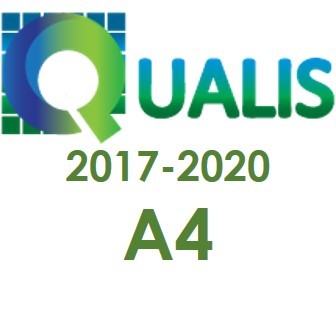Extraction of dyes from tucumã (Astrocaryum tucuma) and açaí (Euterpe oleracea) fruits for application in cotton fabric dyeing
Keywords:
Natural Dyes. Cotton Fabric. Dyeing.Abstract
Natural dyes have been used since prehistoric times and can replace synthetic ones, which have a detrimental impact on the environment. Açaí and tucumã are abundant fruits in the state of Rondônia, serving as sources of natural dyes. In this context, the project evaluated the use of these dyes to dye cotton fabrics. During the dyeing process, immersion time and mordant were assessed, the dyes were characterized by spectroscopy, and the dyeing was conducted using the LAB color system. The results illustrate that the dyes uniformly colored the fabrics and depended on the mordant and dyeing time. Acetone was found to be the best extracting solvent.
Downloads
References
AZEVEDO, L. et al. Corantes naturais e artificiais. Revista de Trabalhos Acadêmicos, Campos dos Goytacazes. v. 2, n. 6, 2016.
BALAN, D.S. Corantes naturais de aplicação têxtil: avaliação preliminar da toxicidade de urucum Bixa orellana L. (Malvales: Bixaceae) e hibisco Hibiscus sabdariffa L. (Malvales: Malvaceae). Revista Brasileira de Gestão Ambiental e Sustentabilidade, João Pessoa. v. 4, n.7, p. 151-157, 2017.
BUENO, A. M. et al. Optimal process conditions to recycled polyester dyeing using natural annatto dye. Journal of cleaner production, Amsterdam, v. 370, 2022.
BUENO, A.M. et al. Colorimetric Analysis of the Stability of Annatto Dye in Solution and Its Use in the Dyeing of Polyester Fibers. Fibers and Polymers, Amsterdam, v.21, n.1, p. 1-6, 2020.
COPINI, S.M. Comportamento tintorial dos ésteres de luteína extraídos de Tagetes erecta L. no tingimento de substrato de algodão. Dissertação (Mestrado em Engenharia Química). Universidade Federal de Santa Catarina, Florianópolis, 2018.
DINIZ, J. F.; FRANCISCATTI, P.; SILVA, T. L. Tingimento de tecidos de algodão com corantes naturais de açafrão e urucum. Iniciação Científica CESUMAR, Maringá, v. 13, n. 1, p. 53–62, 2011.
FULEKI, T.; FRANCIS, F. J. Quantitative methods for anthocyanins. 1. Extraction and determination of total anthocyanin in Cranberries. Journal of Food Science, Chicago, v.33, n.1, p.72-77, 1968a.
GIUSTI, M.; WROLSTAD, R. E. Characterization and Measurement of Anthocyanins by UV-Visible Spectroscopy. Current Protocols in Food Analytical Chemistry, Hoboken, v. 00, p. F1.2.1-F1.2.13, 2001.
GONÇALVES, M. J. et al. Estudo da viabilidade do tingimento da poliamida com corante natural de urucum. Revista Gestão e Sustentabilidade Ambiental, Tubarão, v. 9, n. esp., p. 571–585, 2020.
HOUBEN, J. H. et al. Effect of dietary vitamin E supplementation, fat level and packaging on colour stability and lipid oxidation in minced beef. Meat Science, Amsterdam v. 55, p. 331–336, 2000.
KONG, J.-M. et al. Analysis and biological activities of anthocyanins. Phytochemistry, Amsterdam, v. 64, n. 5, p. 923–933, 2003.
LEVI, M. A. B. et al. Three-way chemometric method study and UV-Vis absorbance for the study of simultaneous degradation of anthocyanins in flowers of the Hibiscus rosa-sinensys species. Talanta, Amsterdam, v. 62, n. 2, p. 299–305, 2004.
LINDINO, C.A. et al. Determinação de metais em corantes alimentícios artificiais. Acta Scientiarum Technology, Maringá, v. 30, n. 1, p. 93-98, 2008.
MAZZA, G. et al. Absorption of anthocyanins from blueberries and serum antioxidant status in human subjects. Journal of Agricultural and Food Chemistry, Washington, v. 50, n. 26, p. 7731–7737. 2002.
MESQUITA, S.S.; TEIXEIRA, C.M.L.L; SERVULO, E.F.C. Carotenoides: Propriedades, Aplicações e Mercado. Revista Virtual de Química, Niterói, v. 9, n.2, 2017.
MELÉNDEZ-MARTÍNEZ, A. J. et al. Relationship between the colour and the chemical structure of carotenoid pigments. Food Chemistry, Amsterdam, v. 101, n. 3, p. 1145–1150, 2007.
OLIVER, J.; PALOÚ, A. Chromatographic determination of carotenoids in foods. Journal of Chromatography A, Amsterdam, v. 881, p. 543–555, 2000.
PINTO, Angelo. C. O Brasil dos viajantes e dos exploradores e a química de produtos naturais brasileira. Química Nova, São Paulo, v. 18, n. 6, p. 608–615, 1995.
PRADO, M. A.; GODOY, H. T. Corantes Artificias em alimentos. Alimentos e Nutrição, Araraquara, v. 14, n. 2, p. 237–250, 2003.
RENHE, I. R. T. et al. Obtenção de corante natural azul extraído de frutos de jenipapo. Pesquisa Agropecuária Brasileira, Brasília, v. 44, n. 6, p. 649–652, 2009.
RODRIGUES-AMAYA, D. B.; KIMURA, M.; AMAYA-FARFAN, J. Fontes brasileiras de carotenóides: Tabela brasileira de composição de carotenóides em alimentos. 2 ed. Brasília: MMA/SBF, 2008.
RODRIGUEZ-AMAYA, D. B. A guide to carotenoid analysis in foods. Washington: ILSI Press, 2001.
RESENDE, L.G.M. et al. Corante de antocianinas extraídas do fruto tropical jambolão: formulação e avaliação da estabilidade dos compostos bioativos. In: OPEN SCIENCE RESEARCH I, 1., 2022, São Paulo. Editora Científica Digital. 2022. p. 38 – 49.
SILVA, G. J. F. et al. Formulação e estabilidade de corantes de antocianinas extraídas das cascas de jabuticaba (MYRCIARIA ssp.). Alimentos e Nutrição. Araraquara, v. 21, n. 3, p. 429-436, 2010.
SOLOMONS, T. W. G. et al. Química Orgânica. 12.ed. Rio de Janeiro: LTC, 2018.
ZANONI BOLDRIN, M.V.; YAMANAKA, H. Corantes, caracterização química, toxicológica, métodos de detecção e tratamento. Unesp Cultura Acadêmica, São Paulo, 2016.
Additional Files
Published
How to Cite
Issue
Section
License
Copyright (c) 2023 Revista Brasileira de Iniciação Científica

This work is licensed under a Creative Commons Attribution-NonCommercial-ShareAlike 4.0 International License.




